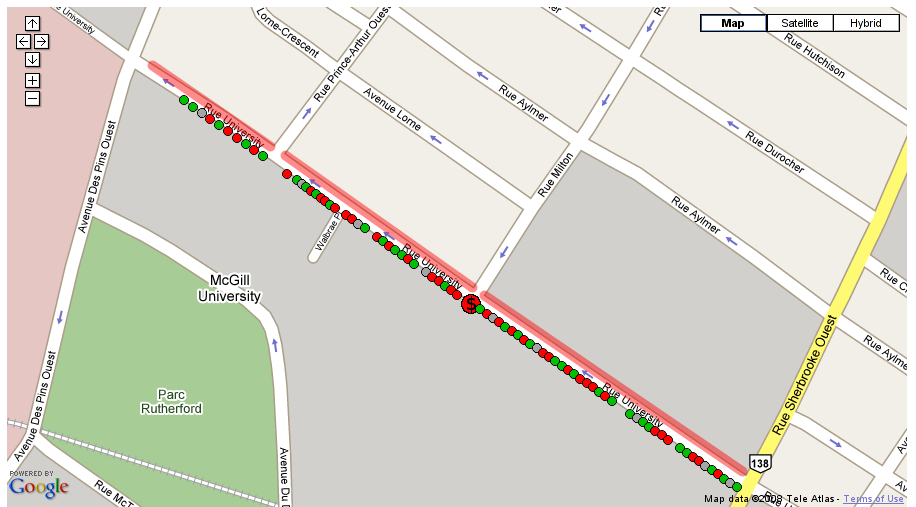| |
Researchers: Yvan Pointurier, Postdoc, Prof. Mark Coates
Undergraduate students: Haohsiang Chen, Xianda Chen, Sharif Nejat, Karim Tadjin, Jason Thomas (software), Andrea Edelstein, Stephen Hopkins, Vincenzo Marcovecchio, Mark Wylie (hardware)
Description:
Recently the town of Montreal has upgraded its parking payment system in numerous areas on the Island to an electronic system, where users key in the number of their spot on paystation devices located near every parking lot and pay for the time they expect to stay; parking controllers have a wireless access to the paystation and only need to compare the data held by the paystation using a wireless handheld specifically designed for this usage (what parking spots are supposed to be free?) with what they actually see (what parking spots are actually occupied?). This project consists in assisting drivers to find available spots to park in Montreal, as well as enabling mobile payment (for instance, through a cell-phone) and facilitating parking management on the regulators' side. This projects consists in two sub-projects. The "system/software" subproject deals with designing and implementing such a system with a focus on software aspects; the "hardware" subproject consists in building a prototype of a sensor to detect car presence automatically.
System/software:
The goal of this subproject is to design a parking management system where information on the occupancy of each spot are centralized, processed, and made available to drivers and parking enforcement authorities in a user-friendly fashion, for instance, through online real-time mapping software.
Both drivers and local parking enforcement authorities will benefit from this project. On the driver side, parking availability will be known in real-time, thereby allowing drivers to make plans before taking their car using a website (how likely am I to find a spot in this area?) or even inside their car as they are driving using a GPS receiver (where is the closest available parking spot?). On the parking authority side, ticket issuance will be greatly facilitated and reduced as both parking occupancy and payment information will be centralized and displayed on the same map at all times. We propose the following methodology to carry out this project. First, a way to gather and access centralized data will be designed. This step may involve a partnership with the City of Montreal or the Montreal-based company which designed the current parking system. Second, occupancy data will be processed and presented in real-time using mapping software such as Google maps. A website will be designed to present the occupancy data. Features will be added to the website to forecast parking occupancy accounting for pricing policies (the parking price depends on the time of the day). The website should also allow the parking enforcement authorities to check parking payment in real-time.
Hardware:
The goal of this subproject is to automate the parking spot occupancy detection using sensors.
Both users and local parking enforcement authorities will benefit from this project. On the user side, a second project will eventually allow them to view on a mapping system (such as their car GPS device) in real-time what parking spots are free as they drive. On the parking authority side, ticket issuance will be greatly facilitated and reduced as both parking occupancy and payment information will be centralized and known at all times. We propose the following methodology to carry out this project. First, a review of possible techniques and sensors to detect reliably the occupancy of a spot will be conducted. The sensor should be small, non-intrusive, relatively cheap and easy to deploy in the city of Montreal where the outdoors temperature amplitude is wide. Sensing devices should also be able to communicate with a centralized computer, most likely in a wireless fashion. Power supply is another issue and solutions using solar energy will be studied. Possible sensors include (but are in no way limited to) sonar sensors and small surveillance cameras. Second, the sensor will be built and tested in a realistic environment, preferably on real parking spots.
Progress:
The software team has designed the system in Fall 2007. A website that implements the proposed system will be up in April 2008. A prototype for the parking detection sensor will be available in March 2008.
Screenshot:

This map shows parking availability in an area in downtown Montreal; plain circles show metered parking spots (green: available, red: occupied, gray: unsure - in the final version of the project, colors will be updated in real-time!), larger circles with dollars show parking lots and thick red lines show residential parking.
|



